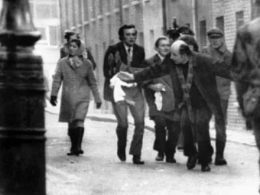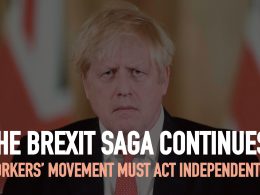By Peter Hadden
THE WORKERS at Visteon – through their month long occupation of their factory – have written an important chapter in the history of the labour movement in Northern Ireland.
Had they done as was demanded of them and meekly left the factory when administrators arrived to take it over they would have walked away with their basic state entitlements and nothing more.
Fortunately the Belfast workforce decided to make a stand. Workers in the other Visteon plants in Basildon and Enfield initially complied with the ultimatum to leave the factories – until the news came through of the Belfast occupation. Encouraged that there could be a fight back, they immediately began occupations of their own. Heavy handed police action plus the use of the courts eventually forced them off the premises but they began round the clock picketing to ensure that the machinery stayed where it was.
The decisive action taken by the workers of the three plants forced Ford/Visteon to come up with a significant redundancy package. This is an important victory which can in turn encourage other workers faced with layoffs and closures and show that resistance is possible.
However, the silence in the Visteon canteen when the ballot result accepting the deal was announced spoke volumes about the attitude of the workers to what had been achieved. Most workers saw it as a victory but only a partial victory. There was anger that the national negotiating officials had come up with a deal that gave less to the non-Ford protected “Cost Competitve Rate” (CCR) workers.
Above all there was deep disappointment that the factory was still to close. For most of those who had maintained the occupation this had not been a struggle for better redundancy terms, it was, first and foremost, a fight to keep the plant open. The fact that Ford has not been forced to reopen the factory is in no way the fault of those who led and those who maintained the Belfast occupation. From day one, the leaders of the occupation saw that the key to winning lay, firstly, in consolidating their position in the factory; secondly, in building support in local communities and other workplaces; and, thirdly, in stepping up the pressure on Ford by organising solidarity action in the Ford factories in Bridgend and Dagenham.
The first two tasks were achieved hands down. The occupation was a model of discipline and organisation from the start. The overwhelming community support was shown in the regular donations of money, food and other essentials and in the stream of people, including trade unionists from other workplaces visiting the factory to back the occupation.
However the third task – to get Ford workers in Bridgend and Dagenham to black the parts brought in to replace those previously supplied by the three Visteon factories – proved more difficult. This was mainly because of the role of the national Unite leaders who, from the very start, dragged their heels and refused to lead from the front on this.
What was needed was a clear instruction to Ford workers from Unite General Secretary, Tony Woodley, not to handle the replacement parts. A clear call from Tony Woodley for the blacking of parts, plus a guarantee that any reprisal by Ford against any workers would be met by strike action throughout the Ford group, would have got a response. For weeks the convenors and shop stewards from the three plants kept up the pressure on the Unite national officials on this.
The question that now remains is that if the occupations and blockades plus the threat of blacking forced Ford to move significantly on the redundancy package, how much more might have been achieved had the Unite leadership acted much earlier and much more decisively to implement the blacking?
Rather than allow these factories to close, they should be taken into public ownership and placed under democratic workers management and pressure must now be put on Gordon Brown and the Assembly parties to deliver on saving these jobs.
The Visteon workers have struck a blow on behalf of workers everywhere. Whatever the final outcome they can walk away from this battle with their heads held high.










